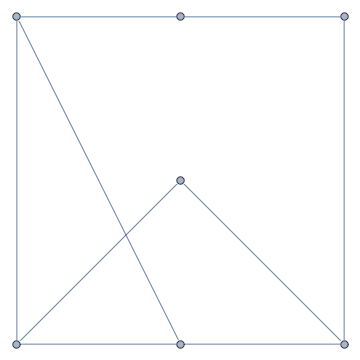Are these 2 graphs isomorphic?
Solution 1:
Once you know, as pointed out in this answer, that $$f(A)=7,\: f(B)=4,\: f(C)=3,\: f(D)=6,\: f(E)=5,\: f(F)=2,\: f(G)=1$$ isomorphism, you can create an animation illustrating how to morph one graph into the other. Let's say that ${vc}_1$ is a list of vertex coordinates for one and ${vc}_2$ is the corresponding list of vertex coordinates for the other. (It's important that the order of the vertex coordinates be dictated by the isomorphism.) We can then morph from one graph to the other using a function like
$$p(t) = t \, {vc}_2 + (1-t) {vc}_1.$$
Here's the result:

Since several folks asked for code generating the animation in the comments, you can find it here:
- In Mathematica,
- In Javascript, and
- In LaTeX.
Solution 2:
There's an isomorphism $f$ given on vertices by
$$f(A)=7,\: f(B)=4,\: f(C)=3,\: f(D)=6,\: f(E)=5,\: f(F)=2,\: f(G)=1.$$
An illustration of the isomorphism is given below:

Solution 3:
If two graphs are isomorphic, then if we represent one of them as an matrix, we can find an adjacency matrix for the other which is identical, except for the names of the nodes and edges.
An adjacency matrix for the left graph is:
A B C D E F G
A: 1 1 1
B: 1 1 1
C: 1 1
D: 1 1 1
E: 1 1 1
F: 1 1
G: 1 1 1
If we identify the vertices as (A B C D E F G) = (7 4 3 6 5 2 1), and write down the adjacency matrix for the second graph in that order, we get the same matrix:
7 4 3 6 5 2 1
7: 1 1 1
4: 1 1 1
3: 1 1
6: 1 1 1
5: 1 1 1
2: 1 1
1: 1 1 1
Of course, the objects are not isomorphic if the names of the vertices are considered significant in the representation. Or if there are constraints, such as that A must be identified with node 1 (because, say, the graph are part of some larger object, and how they connect to it is not negotiable).
Two entities that are considered isomorphic are never identical unless they are the same entity.
An isomorphism is always based on caring about some possible differences, while declaring that others do not matter.
Solution 4:
Yes. In the second graph, slide node 4 out of the square and observe that nodes 1,2,3,7,4,5 now form a hexagon, with node 6 inside it. Node 6 now corresponds to node D. For rigorous details, see Daniel Rust's answer. You can check that his construction is indeed an isomorphism by applying the definition: that for any $a$, $b$ in the first graph, $f(a)$ is connected to $f(b)$ if and only if $a$ is connected to $b$.